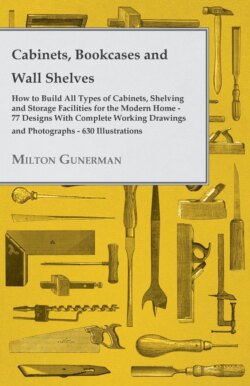Читать книгу Cabinets, Bookcases and Wall Shelves - Hot to Build All Types of Cabinets, Shelving and Storage Facilities for the Modern Home - 77 Designs with Compl - Milton Gunerman - Страница 9
На сайте Литреса книга снята с продажи.
Old COLONIAL Pine Chest Easy to Make and Costs Very Little Holds Blankets or Toys
ОглавлениеEVERY household can find a place for this versatile chest. In the bedroom it will serve for storage of blankets, in the dining room it can be used to hold linens, and in the youngster’s room it will make an ideal chest for toys. Made in traditional Colonial style it is simple enough for home workshop construction and yet fashionable among other furniture copied from the Colonial period.
The chest should be made of kilndried clear white pine. If possible the materials should be obtained in the required widths of 17″ and 20″; otherwise it will be necessary to glue up several pieces of narrow stock to obtain the panels. Front and back members of the chest are made of two pieces of 3/4″ stock finished to a width of 16″ and a length of 41 1/2″. A rabbet, 1/2″ × 3/4″, is cut along each end to take the end members. The end members are made of two pieces of 3/4″ stock finished to an overall size of 16″ × 16 1/2″. Inside faces should be sandpapered before assembly. Front and back members are fastened to the end members with glue and 8-penny finishing nails. The nails are set, then clamps are applied. The assembled case must be checked with a try square to make certain that the corners are square. If it should be out of square, the case should be forced into its proper position and held there by temporary diagonal braces fastened at two corners. This should all be done before the glue has had time to set and prevent later adjustment.
The bottom of the chest measures 3/4″ × 18 1/4″ × 42 3/4″. The edge is molded as shown in the drawing. It can be cut by a standard cutter. The photograph shows this operation on the drill press. If such a cutter is not available, the molding may be cut by a series of saw cuts made on the bench saw and shaped with gouge and plane. The molding should be sandpapered by a block having the same contour. Before the bottom is assembled to the case, the outer surfaces of the case should be sandpapered and all tool marks and blemishes removed. The bottom is fastened to the case with 1 1/2″ No. 8 flat head screws. Holes for the screws should be bored and countersunk in the underside of the bottom at this time.
Photo at right shows how the ends of the chest fit the rabbeted sides to form the case. At left, the bottom panel is shown as the molded edge is being cut by a shaper cutter set up in the drill press
The open lid of this chest needs no support. It can be placed at the end of the bed or against a wall. The undercut lid molding provides this very desirable feature
Feet for chest are made of two scrolled members reinforced by cleat. They are screwed to bottom
Here the top edge of the assembled case is planed so corners are perfectly smooth
Feet for the chest come next. Each foot is made of two members joined together and reinforced with a cleat as shown in the sketch. Eight pieces of 3/4″ stock, 4 1/2″ wide and 5″ long will be required for the feet. Cleats measure 3/4″ × 3/4″ × 4 1/2″. A full-size pattern of the foot can be drawn on graph squares and cut to shape on the band saw or jig saw. A wood file should be used to finish the cut edges. The straight edge of each foot member is mitered at an angle of 45 degrees. This cut can be made on the bench saw by tilting the saw table or arbor. The pieces are fastened together with glue and brads; the cleat is fastened with glue and 1 1/4″ No. 8 flat head screws. The completed feet are attached to the underside of the chest with 1″ No. 8 and 1 1/2″ No. 8 flat head screws. Holes to take these screws-must be bored and counterbored in each foot member as indicated on the drawing.
Top photo shows how a rabbet plane is used to start the molding around the top panel. Second photo shows a block plane being used to round off the edge
The top panel is made of a piece of 3/4″ stock, 19″ wide and 43 1/2″ long. The edge is molded as shown in the drawing. Since this is too large for the average shaper it will have to be done by hand The photographs show the first and second steps of cutting this molding. A rabbet plane is used to produce the rabbet, and a block plane is used to round off the ends and edges. Two battens measuring 3/4″ × 3 1/2″ × 15″ are fastened to the underside of the top to prevent warping. They are held in place with glue and 1 1/4″ No. 10 flat head screws. The top is hinged to the back with 3″ brass butts. The two handles and lock escutcheon plate are fastened in place.
The chest is finished with a coat of boiled linseed oil and turpentine mixed together in equal parts. This application is given a day or two to dry. A coat of pine stain is applied next. Three coats of white shellac follow the stain, and several applications of wax complete the work.
